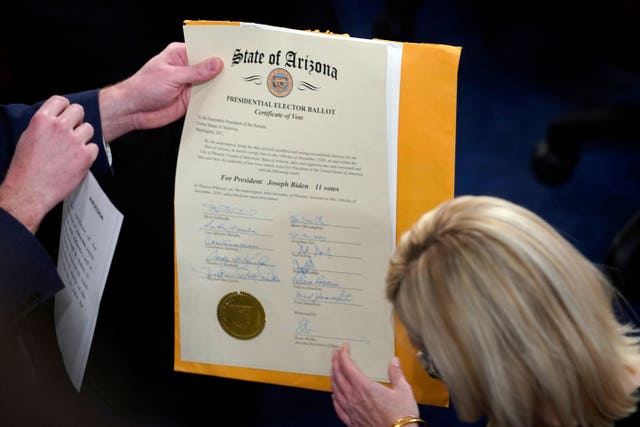What is the Electoral College and how does the US use it to elect presidents?
Some Democrats say that the system favours Republicans and they would rather the United States elect presidents by a simple majority vote.

Donald Trump won the presidency in 2016 because of the Electoral College and so did George W. Bush in 2000, even when neither captured the popular vote.
The Electoral College is the unique American system of electing presidents.
It is different from the popular vote and it has an outsize impact on how candidates run and win campaigns.
Mr Trump and Mr Bush, both Republicans, lost the popular vote during those presidential runs but won the Electoral College to claim the White House.
Some Democrats say that the system favours Republicans and they would rather the United States elect presidents by a simple majority vote.
But the country’s framers set up the system in the constitution, and it would require a constitutional amendment to change.
Here is look at the Electoral College and how it works:
– What is the Electoral College?
The Electoral College is a 538-member body that elects a president. The framers of the constitution set it up to give more power to the states and as a compromise to avoid having Congress decide the winner.

Each state’s electors vote for the candidate who won the popular vote in that state. The runner-up gets nothing, except in Nebraska and Maine where elector votes are awarded based on congressional district and state-wide results.
To win the presidency, a candidate must secure 270 electoral votes – a majority of the 538 possible votes. Mr Trump crossed that threshold early on Wednesday with a win in Wisconsin.
– How is it different from the popular vote?
Under the Electoral College system, more weight is given to a single vote in a small state than to the vote of someone in a large state, leading to outcomes at times that have been at odds with the popular vote.
It also affects how candidates campaign. Because the outcome is almost certain in solidly Republican states and solidly Democratic states, candidates tend to focus most of their efforts on a handful of swing states that have split their votes in recent elections.
– How many electoral votes does each state have?
Electors are allocated based on how many representatives a state has in the House of Representatives, plus its two senators. The District of Columbia gets three, despite the fact that the home of Congress has no vote in Congress.
California has the most electoral votes at 54, followed by Texas with 40 and Florida with 30. Pennsylvania, with 19 electoral votes, is the largest prize of the presidential battlegrounds, followed by Georgia and North Carolina with 16 each.
– Who are the electors?
It varies by state, but often the electors are chosen by state parties. Members of Congress cannot serve as electors.
– How and when are the votes counted?
After state election officials certify their elections, electors meet in their individual states, never as one body, to certify the election. This year, that will happen on December 17.

If the two candidates have a tied number of votes, the election is thrown to the House, where each state’s congressional delegation gets one vote. That has happened only twice, in 1801 and 1825.
Once a state’s electors have certified the vote, they send a certificate to Congress. Congress then formally counts and certifies the vote at a special session on January 6. The vice president presides as the envelopes for each state are opened and verified.
– Can lawmakers object?
Lawmakers can object to a state’s results during the congressional certification, as several Republicans did after the 2020 election.
On January 6, 2021, the House and Senate both voted to reject GOP objections to the Arizona and Pennsylvania results.
After Mr Trump tried to overturn his defeat to Democrat Joe Biden and Mr Trump’s supporters stormed the Capitol on January 6, Congress updated the 1800s-era Electoral Count Act to make it harder to object and to more clearly lay out the vice president’s ceremonial role, among other changes.
Mr Trump had pressured then vice president Mike Pence to try to object to the results, something the vice president has no legal standing to do.
Once Congress certifies the vote, the new or returning president will be inaugurated on January 20 on the steps of the Capitol.





